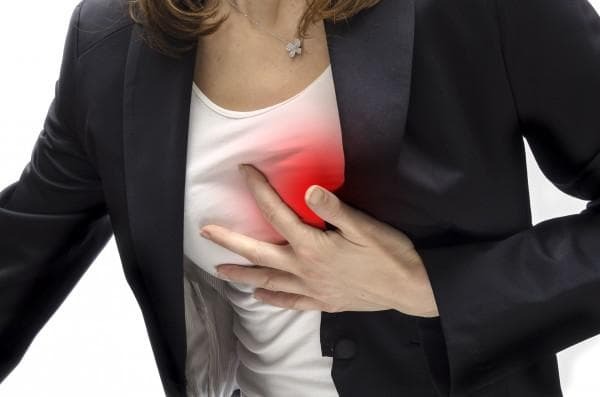
Angina is an infectious disease that is inflammatory in nature and affects the area of the throat and pharynx. This pathology is considered one of the most frequently diagnosed, can be caused not only by infection, but also by some other factors. Angina should be treated at a professional level with the use of medicines( some folk remedies can not be avoided).If you ignore the prescriptions / recommendations of doctors or not complete the course of therapy, serious complications can arise.
Contents
- 1 Types of angina
- 2 Symptoms and Diagnosis
- 3 Complications of sore throat
- 3.1 Heart
- 3.2 Kidney
- 3.3 Joints
- 3.4 Ears
- 4 Video
Types of angina
In medicine, there are several types of the disease under consideration, each of which has its own special characteristics.
-
 Catarrhal. The easiest type of sore throat, which occurs even without hyperthermia( fever).To the main signs of the disease, angina can be attributed to a slight sore throat, unintentional pain when swallowed food / fluid, a slight cough, a mild weakness in the body. As a rule, the symptoms of catarrhalic angina passes literally on day 3, but if there has been no treatment since the first hours of the disease, then surely the disease will simply go to a different kind - more severe.
Catarrhal. The easiest type of sore throat, which occurs even without hyperthermia( fever).To the main signs of the disease, angina can be attributed to a slight sore throat, unintentional pain when swallowed food / fluid, a slight cough, a mild weakness in the body. As a rule, the symptoms of catarrhalic angina passes literally on day 3, but if there has been no treatment since the first hours of the disease, then surely the disease will simply go to a different kind - more severe.
- Follicular. Always starts with a sudden increase in temperature, the indications can be critically high, which leads to chills and fever. The patient experiences all the manifestations of body intoxication - general weakness, mild dizziness, muscle pains( "twists") and formulations, often a non-intensive pain syndrome appears in the heart.
- Lacunar. Symptoms of this type of sore throat are very similar to those of follicular sore throat, but the first type is always more severe. In addition to swelling of palatine tonsils and pharynx in the folds, white( a new layer of
and yellow) is formed. Note: lacunar and follicular angina can be diagnosed in the patient at the same time. - Fibrinous. Begins with a sharp rise in temperature, chills and fever, signs of intoxication. A distinctive feature of this type of angina is the presence of white plaque, which extends beyond the palatine tonsils and is a continuous "cover". Important: with fibrinous angina, a physician must differentiate it from diphtheria.
- Herpetic. This type of sore throat is characterized not by the classical onset of development - since
begins to complain of symptoms of the flu, then symptoms of the actual sore throat - sore throat, perspiration, general signs of intoxication( poisoning) of the body begin to appear in 1-2 days. And only on the 3-4th day of the disease the patient can find the sore throat and palate characteristic of the herpetic appearance of the sore throat.
In addition, in medicine, distinguish still phlegmonous tonsillitis and ulcerous-necrotic. But they are always a consequence of untreated above-mentioned types of angina.
Symptoms and Diagnosis
Of course, for each type of angina there are certain symptoms, but there are a number of signs of this disease that will be characteristic of all species.
- First, it's a temperature increase. It is always sudden, develops rapidly - with angina subfebrile indicators there is no temperature. Hyperthermia rates are so high that the patient is overcome by chills and fever - this is also considered a symptom of angina.
- Secondly, a sore throat. Almost immediately after getting the infection in the body it hurts
and will complain about for choking and sore throat. At first it is mild, but within 12-24 hours it can develop up to the maximum intensity - the patient sometimes does not even have its own saliva swallowed by the
for choking and sore throat. At first it is mild, but within 12-24 hours it can develop up to the maximum intensity - the patient sometimes does not even have its own saliva swallowed by the
. - Third, signs of intoxication. There was not yet in the history of medicine a patient with a sore throat who could lead a habitual way of life. There is always weakness, sluggishness, drowsiness, lack of appetite, pain( "aching") in the muscles and joints, attacks of nausea( but without vomiting).
It is easy to diagnose angina, only in some cases it will be necessary to conduct a specific examination - this is necessary for the differentiation of diphtheria.
 Which nebulizer for the common cold and coughing is most often chosen, indicated here.
Which nebulizer for the common cold and coughing is most often chosen, indicated here.
How to make a solution for a nebulizer with a common cold is indicated here.
What are the most popular recipes for a nebulizer from the common cold for children, is listed here: http: //prolor.ru/n/ lechenie-n / ingalyacii-pri-nasmorke-nebulajzerom-recepty-dlya-detej.html
Usually the diagnostic procedures for detecting any type of angina are as follows:
- Survey of the patient - when signs appeared, how intense, whether the chair was changed( constipation / diarrhea).
- Inspection of the patient - the appearance of the skin and mucous membranes is checked, the surface of the tongue and throat is inspected, even a slight reddening of the latter gives an occasion to diagnose angina.
- Thorough examination of the throat, possibly with the use of special equipment.
- Laboratory analysis of blood tests - high level of leukocytes will be noted.
Complications of sore throat
Angina is an insidious disease of an infectious and inflammatory nature that can give complications in principle to any organs and systems in the body. Of course, the medicine is a kind of statistics - it was found that most of the angina "leaves traces" only on some organs.
Heart

Complications on the heart - the most common complications after angina
Most often, angina gives a complication to the most important organ in the body - the heart. This complication is manifested in the form of rheumatic damage to the tissues of this organ. The fact is that in case of complications the connective tissues are mostly affected, and in fact they are accumulated in the heart in the greatest quantity.
 How to choose an inhaler from a cough and runny nose is indicated in the article.
How to choose an inhaler from a cough and runny nose is indicated in the article.
How the rhinitis is treated with an inhaler in children is indicated in the article.
It is noted that rheumatic heart disease is diagnosed more often in patients under the age of 15 years after the transferred angina. The danger of such a complication lies in the external well-being of the patient's health - without a specific examination and consulting a cardiologist it is problematic even to suspect the existing complications.
Remember! Rheumatic damage to the connective tissue of the heart leads to the development of various vices and makes the patient disabled.
Kidneys
 Doctors say that it is the kidneys that take a blow due to angina - this is the second organ in the frequency of complications. As a rule, as complications, pyelonephritis and glomulonephritis are considered - inflammatory processes affecting the calyx-pelvic area of the organ. Two or one kidneys are affected with the same frequency, but signs of such complication arise no later than 14 days after getting rid of sore throat. The patient begins to complain of back pain, fever, changes in urination.
Doctors say that it is the kidneys that take a blow due to angina - this is the second organ in the frequency of complications. As a rule, as complications, pyelonephritis and glomulonephritis are considered - inflammatory processes affecting the calyx-pelvic area of the organ. Two or one kidneys are affected with the same frequency, but signs of such complication arise no later than 14 days after getting rid of sore throat. The patient begins to complain of back pain, fever, changes in urination.
Pyelonephritis / glomerulonephritis should be treated and monitored only in the hospital. Self-medication is unacceptable, as this can lead to the development of chronic pathological processes.
Joints

Most often, after a sore throat, rheumatoid arthritis is diagnosed
If complications of angina give on the joints, then for sure the rheumatic component of the pathologies will be detected. And more often after the transferred angina is diagnosed rheumatoid arthritis, moreover, it affects mainly the knee joints, but sometimes the patient also notes all the signs of the disease on smaller ones. Symptoms of rheumatoid arthritis include swelling and soreness in the joints, a violation of their mobility, redness and fever at the place of the affected joint.
The danger is that rheumatoid arthritis is considered an incurable disease - you can only correct the patient's condition, making it easier for him to have uncomfortable and painful sensations.
Ears
Otitis( inflammation of the middle ear) is most often diagnosed as a complication after catarrhal angina, but is often found against the background of other types of this infectious inflammatory process. Pain in the ear, sometimes unbearable, with irradiation in the jaw and head, a rise in temperature - all this, of course, is quickly treated.
The danger of complicating angina to the ears is that with the development of chronic otitis, partial or total hearing loss may occur.
Video
More information about angina you will learn from this video:
Angina only at first glance is a safe disease - many in general are sure that it can be hurt at least every month. And here the statistics "speaks" about the other - the percentage of complications grows steadily from year to year. To save yourself from such trouble, you should listen to the generally accepted recommendations:
-
 The sore throat should "flow" in the recumbent position - the patient must be kept bed rest. Otherwise, when the disease is transferred "on the legs", rheumatoid joints develop.
The sore throat should "flow" in the recumbent position - the patient must be kept bed rest. Otherwise, when the disease is transferred "on the legs", rheumatoid joints develop. - It is necessary to drink a lot - it will help to remove toxins from the body and significantly reduce the level of intoxication.
- After treatment, you should not immediately join in an active life - for a couple of weeks, limit yourself to physical exercises and entertainment activities.
Avoiding complications after angina is very realistic - you need to correctly treat the inflammatory-infectious process, engage in strengthening and enhancing immunity and be under the supervision of doctors until the complete disappearance of even the slightest sign of the disease.
